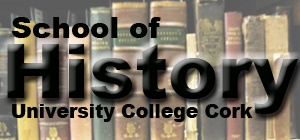News Archive
The Book of Lismore at University College Cork

A rare Irish medieval manuscript is on public view for the first time during a major exhibition at University College Cork. The Lewis Glucksman Gallery is currently hosting an exhibition featuring the Book of Lismore, Leabhar Meic Carthaigh Riabhaigh, a fifteenth century manuscript, entitled: Travelled Tales – Leabhar Siúlach, Scéalach: The Book of Lismore at University College Corkuntil the end of October.
The exhibition was officially opened by Ms. Fiona Kearney, Director of the Lewis Glusksman Gallery; Dr. Michael Murphy, President, University College Cork; His Grace Peregrine Cavendish, 12th Duke of Devonshire; Prof. Máire Herbert, Roinn na Sean-agus Meán-Ghaeilge, University College Cork; and Mr. John Fitzgerald, Librarian, University College Cork.
Opening the exhibition at the Lewis Glucksman Gallery, Dr. Michael Murphy commented on the apparent incongruity of hosting an exhibition about a book at a time in human history when the book itself seems to be giving way to digital applications. Yet, if there is anything we can learn from The Book of Lismore, he added, it is that text, itself, is fluid and that the book still continues to have relevance for a digital age.
In her address, Prof. Máire Herbert spoke of The Book of Lismore as encapsulating the cultural heritage of Cork, Munster and Ireland. Its survival illustrates the multi-layered histories and traditions of our past. The survival of the book is a witness to what Herbert called, “the fragility of textual transmission”.
The Book of Lismore occupies a unique position in the sometimes complex historical interactions between Ireland and Britain, moving as it has between these distinct but complementary cultures and societies, and reinforcing the significance of the book as a powerfully symbolic cultural artefact.
The history of the manuscript begins in the late fifteenth century, when it was compiled for noble patrons, Finghin Mac Cárthaigh (McCarthy) Riabhach, and his wife, Caitilín (formerly a Fitzgerald). The writing probably took place at the Franciscan house at Timoleague, in west Cork, which was associated with the family of Mac Carthaigh Riabhach since its foundation. The manuscript contains a large number of important texts: many drawn from Irish narrative tradition, some which are also translations of contemporary European works, and reflect a lively curiosity about the wider world. Works such as Acallam na Senórach, in which St Patrick is represented in dialogue with survivors of the Fianna, are believed to be amongst the greatest masterpieces of medieval Irish literature, while works such as the Biblical apocryphon, Tenga Beth-Nua (“The Evernew Tongue”), and the Irish translation of the Travels of Marco Polo provide unique insights into Irish reception of external literature, both ecclesiastical and secular.
The Book's travels are as note-worthy as its content. It was probably kept at Kilbrittain Castle in west Cork, the Mac Carthaigh Riabhach residence, until the early 1640s, when, after capture in a siege, it was given into the possession of the Earl of Cork at Lismore Castle, County Waterfold. Walled up in the following century, possibly for safe keeping, it was rediscovered, along with an eleventh century crosier during renovation work on Lismore Castle in 1814. In 1815 it was lent to a Cork antiquary, Donnchadh Ó Floinn, and was transcribed by numerous local scribes before being returned to Lismore Castle. By the 1860s, the Book was restored to its present state and remained for the most part at Lismore until the late 1920s. It was later transferred to its present home at Chatsworth, in Derbyshire, ancestral seat of the Dukes of Devonshire.
In the tradition of the aristocratic virtue of noblesse oblige, His Grace The Duke of Devonshire spoke of his family’s role as curators of cultural heritage and of their commitment to establishing opportunities for scholars and the public to see and study these items. Dr. Michael Murphy noted that the exhibition of the Book of Lismore in Cork in 2011 constitutes a major event in the cultural history of Munster. He acknowledged the generosity of the Trustees of the Chatsworth Settlement Trust, the Duke of Devonshire and his son Lord William Burlington, in having consented to loan the Book to the university for the duration of the exhibition as well as ancillary material relevant to its history including a portrait of Sir Richard Boyle (1st Earl of Burlington, 2nd Earl of Cork) by Sir Anthony van Dyck and related manuscript material. He also thanked colleagues at Chatsworth, particularly Mr. Matthew Hirst, Head of Arts and Historic Collections, who have facilitated the loan. Mr. John Fitzgerald and Ms. Fiona Kearney acknowledged contributions made by Prof. James Knowles, School of English, University College Cork; Dr. John Carey, Roinn na Sean-agus Meán-Ghaeilge, University College Cork; Mr. Matt Packer, Curator of Exhibitions, Lewis Glucksman Gallery; Mr. Crónán Ó Doibhlin, Head of Special Collections, Archives and Repository Services, Boole Library, University College Cork and to the work of their respective teams.
Travelled Tales – Leabhar Siúlach, Scéalach: The Book of Lismore at University College Cork will be open to the public from 27 July to 30 October 2011 at the Lewis Glucksman Gallery, Cork. An educational programme, with contributions from the School of History at University College Cork is scheduled to accompany the exhibition during the autumn.
For further details follow Lewis Glucksman Gallery on Facebook.
